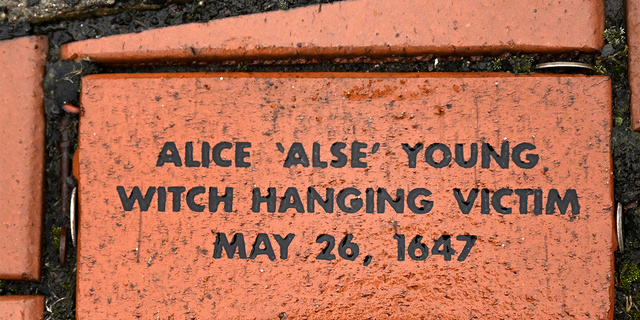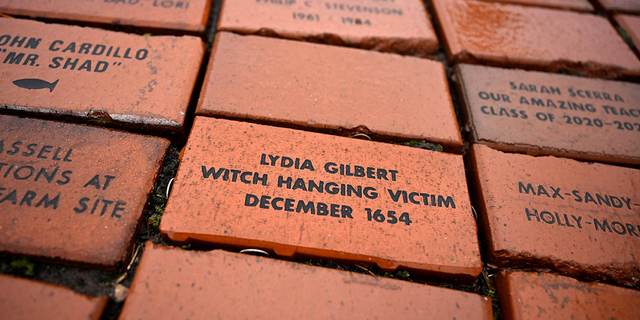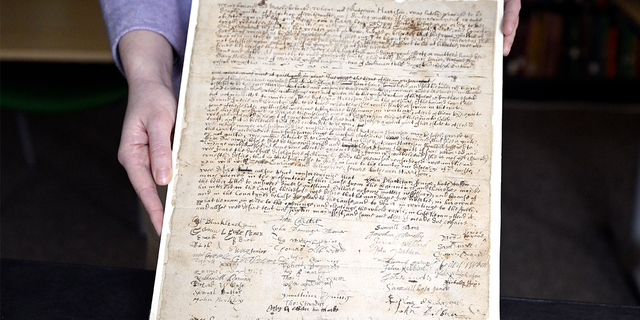Connecticut may acquit those accused of witchcraft
Hundreds of years after the first person was executed in the American colonies for witchcraft, Connecticut lawmakers are considering exonerating the accused.
The executions of these accused witches in Connecticut occurred decades before the infamous Salem witch trials.
Else Young was killed on the gallows in Connecticut on May 26, 1647. She was the first of nine women and two men executed by the Connecticut Colony for witchcraft over 15 years. More than 40 people were put on trial on charges of having links with Satan.
Amateur historians, researchers, and descendants of accused witches and their accusers are now pushing Connecticut lawmakers to finally offer posthumous rehabilitation.
CONNECTICUT MAN GETS 120 YEARS FOR DOUBLE MURDER OF FATHER AND SON IN 1987

In this photo taken on Tuesday, January 24, 2023, a brick commemorating Alice “Els” Young is placed in the Brick Heritage City installation in Windsor, Connecticut. Young was the first recorded person to be executed in the 13 colonies for witchcraft.
And while demands for rehab are nothing new, the calls have grown louder as many genealogy buffs discover their distant relatives were involved in witch trials in Connecticut.
“They talk about how this has haunted their families for generations and how they would love it if someone just said, ‘Hey, that was wrong,'” Connecticut Rep. Jane Gharibay said.
Garibai proposed a resolution of acquittal after receiving letters from relatives in the eighth and ninth generations of the accused witches.
Witch trials in Connecticut were held in the mid to late 1600s. At the time, witchcraft was considered a capital crime in every New England colony.
The earliest laws in the Connecticut colony stated that “any man or woman (to) be a witch, that is, to have or consult with a familiar spirit, they must be put to death.”
Many historians say that fear and anxiety among the religiously strict English settlers sparked the witch trials. They pointed out that life during this period was very difficult due to epidemics, floods, cold winters and famine. Accusations of witchcraft often began because of a quarrel, the death of a child or a cow, or because of butter that could not be churned.
Many of the witches accused of executing were poor single mothers, including Mary Johnson, a maid from Wethersfield, Connecticut, who was accused of “acquainting the devil.”

In this photo taken on Tuesday, January 24, 2023, a brick commemorating Lydia Gilbert is placed in the city’s Heritage Bricks in Windsor, Connecticut. In 1651, an accident during a local militia exercise led to Lydia being accused of witchcraft and hanging. Gilbert.
Johnson was tortured for many years by a local priest who whipped her until she finally confessed that she was a witch and “unclean with men”. She was allegedly hanged after she gave birth to a child by a man she was not married to.
“It’s important to correct the mistakes of the past, so we learn from them and move on, rather than repeating those mistakes,” said podcast host Joshua Hutchinson, who traced his lineage back to accused witches in Salem.
Hutchinson said that in recent decades people have been killed in many countries because they were considered witches or sorcerers.
Connecticut Senator Saud Anwar also proposed an acquittal bill and acknowledges that some people might scoff at the idea that it would take the Legislature time to clear the records of accused witches. But posterity is feeling some “serious things,” he said, adding that one of the voters asked for the resolution.
“His wish was that if there was a way to close families, that would be one way he could say he did his share, even if his ancestors might not have done the right thing. thing,” said Anwar.
APPROXIMATELY 100,000 CHICKEN DIE IN CONNECTICUT FARM FIRE, OFFICIALS SAY

Connecticut Historical Society contributor Julia Morrow displays the original 1669 letter of complaint against Katherine Harrison, Tuesday, January 31, 2023, in Hartford, Connecticut. Harrison of Wethersfield, Connecticut was tried several times for witchcraft.
Other states and countries have tried to redeem themselves for persecuting people for witchcraft in the past, including the Scottish Prime Minister last year formally apologized to some 4,000 Scots who were accused of witchcraft before 1736. About 2,500 of the 4,000 defendants were killed. A member of the Scottish Parliament called for their posthumous pardon.
CLICK HERE TO GET THE FOX NEWS APP
Massachusetts lawmakers in 2022 officially exonerated Elizabeth Johnson Jr., who was convicted of witchcraft in 1693 and sentenced to death during the Salem witch trials. Johnson is considered the last Salem witch accused to have her sentence overturned by lawmakers.
And in 2006, former Virginia Gov. Tim Kaine unofficially pardoned Grace Sherwood, a widowed midwife who was accused by neighbors of destroying crops, killing livestock and creating storms, before facing accusations of being a witch. Sherwood was thrown into the river with her hands tied to see if she could swim, which was considered a sign of guilt. She was able to free herself and spent seven years in prison.
The Associated Press contributed to this report.
Dallas Press News – Latest News:
Dallas Local News || Fort Worth Local News | Texas State News || Crime and Safety News || National news || Business News || Health News
texasstandard.news contributed to this report.









